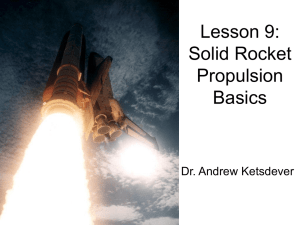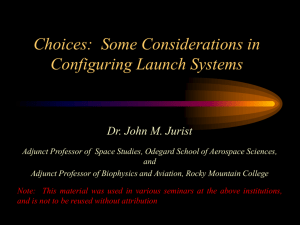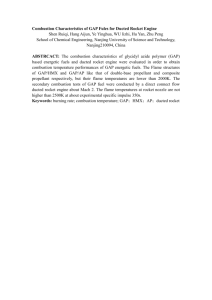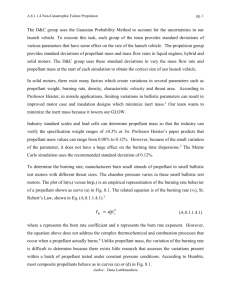Document 14303894
advertisement
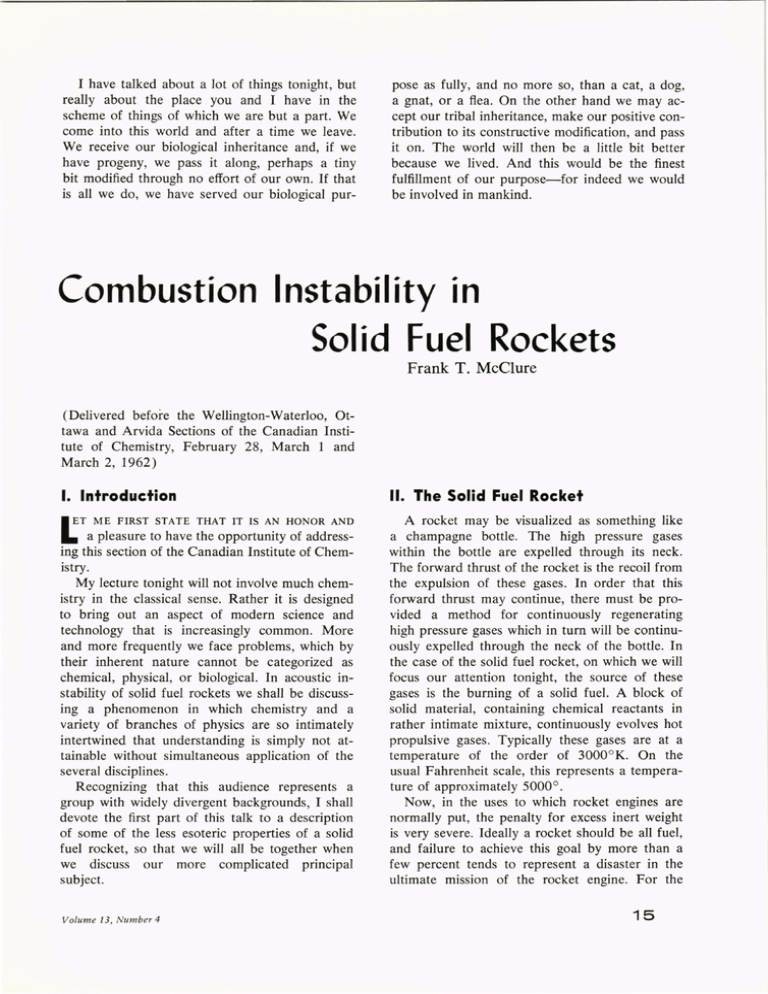
I have talked about a lot of things tonight, but really about the place you and I have in the scheme of things of which we are but a part. We come into this world and after a time we leave. We receive our biological inheritance and, if we have progeny, we pass it along, perhaps a tiny bit modified through no effort of our own. If that is all we do, we have served our biological pur- pose as fully, and no more so, than a cat, a dog, a gnat, or a flea. On the other hand we may accept our tribal inheritance, make our positive contribution to its constructive modification, and pass it on. The world will then be a little bit better because we lived. And this would be the finest fulfillment of our purpose-for indeed we would be involved in mankind. Combustion Instability in Solid Fuel Rockets Frank T. McClure (Delivered before the Wellington-Waterloo, Ottawa and Arvida Sections of the Canadian Institute of Chemistry, February 28, March 1 and March 2, 1962) I. Introduction II. The Solid Fuel Rocket I A rocket may be visualized as something like a champagne bottle. The high pressure gases within the bottle are expelled through its neck. The forward thrust of the rocket is the recoil from the expulsion of these gases. In order that this forward thrust may continue, there must be provided a method for continuously regenerating high pressure gases which in turn will be continuously expelled through the neck of the bottle. In the case of the solid fuel rocket, on which we will focus our attention tonight, the source of these gases is the burning of a solid fuel. A block of solid material, containing chemical reactants in rather intimate mixture, continuously evolves hot propulsive gases. Typically these gases are at a temperature of the order of 3000 0 K. On the usual Fahrenheit scale, this represents a temperature of approximately 5000° . Now, in the uses to which rocket engines are .normally put, the penalty for excess inert weight is very severe. Ideally a rocket should be all fuel, and failure to achieve this goal by more than a few percent tends to represent a disaster in the ultimate mission of the rocket engine. For the ET ME FIRST STATE THAT IT IS AN HONOR AND . . a pleasure to have the opportunity of addressing this section of the Canadian Institute of Chemistry. My lecture tonight will not involve much chemistry in the classical sense. Rather it is designed to bring out an aspect of modern science and technology that is increasingly common. More and more frequently we face problems, which by their inherent nature cannot be categorized as chemical, physical, or biological. In acoustic instability of solid fuel rockets we shall be discussing a phenomenon in which chemistry and a variety of branches of physics are so intimately intertwined that understanding is simply not attainable without simultaneous application of the several disciplines. Recognizing that this audience represents a group with widely divergent backgrounds, I shall devote the first part of this talk to a description of some of the less esoteric properties of a solid fuel rocket, so that we will all be together when we discuss our more complicated principal subject. Volume 13, Num ber 4 15 practitioners of metallurgy, for the specialist in ceramics, for the connoisseur of plastics, for the purveyor of fiber glass and for the inventor of adhesives, this engine has provided a major challenge. New materials, new techniques of the fabrication in new fashions , and new methods of joining metals to metals or metals to other materials have been required. All these materials and their bonds must be compatible with an atmosphere of a high pressure, high temperature, chemically very reactive gas. They must be fabricated in shapes and sizes essential to the needs of the rocket ballistician. These needs are often exacting, sometimes even more exacting than the ballistician himself realizes. whether equilibrium will be maintained throughout the process so that the energy stored chemically, and in the internal modes of the molecules, will become available as directed kinetic energy. While a number of valuable studies have been made in this area, the question must be considered as still open with respect to at least some fuels , and of considerable importance for rocket engines designed for exacting missions. Here, the pertinent areas of science are the physics of relaxation processes and, perhaps more importantly, the chemical kinetics of the high temperature, gas phase, chemical reactions-both areas in which much remains to be learned. IV. The Combustion of the Solid III. The Propulsion Gases We have previously noted that it is the ejection of the propulsive gases which provides the recoil responsible for the thrust of the rocket engine. What properties of the gas are important in this respect? What determines how much impulse one obtains from the ejection of a given mass of gas? Well, it depends upon the enthalpy or heat content of the gas per unit mass. In simple terms then, it depends on the temperature of the gas, and upon its molecular weight, among other things. One could reasonably expect, therefore, that this important property of a fuel could be estimated by knowing the heat of formation of the solid fuel and its atomic composition. This expectation is correct. One can calculate the specific impulse of a fuel from just this knowledge, providing one uses the full technique of statistical thermodynamics and has an adequate supply of spectral and other data in order to estimate with accuracy the properties of all the interesting component molecules of the rather complex propulsive gas. These remarks presume, however, that all of the gas phase chemical reactions involved are so fast that local chemical equilibrium is preserved throughout the process. Certainly one wants to release as much energy as possible during the time the gas resides in the combustion chamber. Even then there are questions. The flow of the gas through the nozzle (i.e., the neck of the bottle) occurs in a time that is ordinarily less than one millisecond. At the same time, the temperature is dropping very rapidly due to the adiabatic expansion. There is thus a real question as to 16 We have thus far discussed the properties of the propulsive gas and the problems associated with it. We have been assuming that the steady combustion of an appropriate solid will produce this gas as needed. It is time now to turn to the question of the properties which must be required of this solid. First let us examine Fig. 1, which is a schematic representation of a rocket motor, and consider the mass balance. The rate of exhaust of the gas will be proportional to the pressure and the cross sectional area of the throat (the narrowest part of the nozzle). The constant of proportionality is called the discharge coefficient and is a thermodynamic property of the gas determined by its temperature, molecular weight, and heat capacity ratio. If the pressure is to remain constant, this discharge rate must be counterbalanced by the production rate arising from gasification of the propellant, and we must examine this rate. First, it is known that practically all of the activity of interest takes place in the extremely thin layer immediately at the surface of the solid propellant. The thickness of this layer is a matter of some >I- >~-----------~ 5 PROPELLANT CHANNEL o ~.--------------, ~ SOLID PROPELLANT Fig. I-Schematic representation of a solid propellant rocket. APL Technical Digest argument, and probably varies from one propellant type to another. However, it seems fairly clear that in almost all cases it is less than 100 microns thick. That is, all of the chemistry, and in fact physics, of the process of steady combustion of a solid propellant occurs in a layer that is less than 1/ 250 of an inch across. Within this very short distance, we observe the transformation from cold solid to very hot burned gases. Since this layer is so small compared to the radius of curvature of the geometries usually encountered, we will expect the solid surface to regress everywhere normal to itself. The velocity of this regression is called the linear rate of burning, r. The value of r, and its dependence on the environmental characteristics, is a characteristic property of the propellant. The equation for the balance between discharge and production of gas is w I- « a: ~ o....J u.. en en « :2 / / / psSr ::::::::CDAtP, where we have noted that the product of the linear burning rate and the surface area, S, of the propellant gives the volume of solid burned per unit time. This multiplied by the density of the solid, ps, gives us the mass rate of production of gas. Under steady state burning conditions, this is equal to the product of the discharge coefficient CD, the throat area, A t , and the gas pressure, P. Now, other things being equal, the linear burning rate for a given propellant is determined by the pressure of the gas. Thus if we have designed our geometry of the propellant to keep S constant as it burns away, our mass conservation equation implies that the rocket will operate at a constant pressure. With knowledge of the particular form of the pressure dependence of the burning rate, we may find this pressure, as illustrated. One must inquire, however, whether this mass balance is really an equilibrium one. The problem is illustrated in Fig. 2. If the pressure is too high, the rate of exhaust should exceed the rate of generation so that the pressure will fall, and, on the other hand, if the pressure is too low, the rate of generation should exceed the rate of exhaust so that the pressure will rise. Since the rate of exhaust, as previously stated, is proportional to the pressure, it becomes clear that a satisfactory propellant must have a pressure dependence of the rate of evolution of gas which is less steep than a direct proportionality. In other words, if we Volume 13, N umber 4 w I- « a: ~ o....J u.. en en « :2 / / PRESSURE Fig. 2-Relationship between the rates of gas generation and gas exhaust in a rocket; (a) stable steady state, (b) unstable steady (?) state. represent this rate of burning of the solid as proportional to the pressure to some power, then that power must be less than unity. To make a long story short, it is not only necessary that that power be less than unity, but highly desirable that it be as low as possible. In addition to depending on the operating pressure, the rate of burning of the solid propellant depends strongly on the temperature of the solid propellant (which is for all practical purposes the temperature which it had attained prior to the ignition of the motor) . Again, since the rocket is expected to perform well under a wide variety of conditions, it is highly desirable that this tem- 17 perature coefficient of the rate of burning be as small as possible. It is important to note that gas flow parallel to the propellant also influences the linear burning rate. This phenomenon is called erosive burning. The flow field is such that this effect varies from one end of the motor to the other. Furthermore, it changes with time as the channel for the gas to flow in opens up. However, reasonable ingenuity in design of the geometry of the grain allows one to program a variation in the surface area of the propellant to counterbalance these effects. v. music. Two types of notes will be heard. The low notes with constant or slowly rising pitch are the axial modes of acoustic oscillation of the propellant channel. Here the gas in the channel is in oscillatory motion essentially the same as the gas in an organ pipe. The high notes with a falling frequency are the transverse modes of the channel. In these modes the oscillation is in a plane perpendicular to the axis of the cylinder. INHIBITOR Acoustic Resonance Now let us suppose that the designer of the solid fuel rocket engine has been meticulously careful with respect to the subjects discussed above. He has selected a propellant with all the appropriate properties tested experimentally in laboratory equipment. His chambers have been tested hydrostatically to take the design pressure with a reasonable safety factor. The geometry of his design has been carefully checked by several assistants . All the criteria for a perfectly satisfactory motor have been met. The motor is designed and built. Comes the day of the test. The countdown proceeds, the firing button is pressed, and the whole thing blows up. Or perhaps he is not that fortunate. Perhaps the first test is completely successful. Perhaps he even has repeated successes under those particular firing conditions. Then a little later, just after everyone is thoroughly satisfied, a slight change is made. A slightly different firing temperature is used or some very insignificant modification is made to some trivial internal component. The button is pressed and the motor blows up. Strange as these events may be, I assure you that they are entirely too common. Figure 3 illustrates that something has gone wrong in our calculations. The pressure time curve is certainly not flat and the propellant grain has not burned as expected. The burning rate of the grain midway between the ends has certainly, on the average, been higher than elsewhere, with the result that the grain has been hollowed out. Let me now playa tape taken from some actual firings of such motors. This tape is a recording taken from the output of special high frequency (up to 20 kc or better) pressure gages placed inside the motor. You will hear some peculiar 18 ROCKET MOTOR ROPELLANT INHIBITOR (e) PROPELLANT PARTIALLY BURNED GRAIN PROPELLANT GRAINS /DESIGN 100: ( L ______________ ---'J"'-- r:~[1\-----~ (f) W g: 2000 - f\ . 1000r (\ '--',-----, BURNING A ~ IINNTT~ERRUPTED I' o PRESSURE-TIME RECORDS Fig. 3-Consequences of acoustic resonance in a solid propellant rocket. (a) S;chematic diagram of rocket motor; (b) longitudinal section of propellant grain; (c) longitudinal section of partially burned grain. (Below) interrupted burning pressure-time records: top, expected pressure-time history of burning; middie, observed pressure-time history of burning; bottom, pressure-time history of interrupted burning. APL Technical Digest (a) VIOLENT HIGH FREQUENCY PRESSURE OSCILLATIONS ARE OBSERVED WITH INTENSE VIBRATIONAL EFFECTS. (b) THE PRESSURE OSCILLATIONS MAY BUILD UP SMOOTHLY FROM ARBITRARILY SMALL RANDOM FLUCTUATIONS, OR A MOTOR MAY BURN STABLY UNLESS SUBJECTED TO SOME RATHER SIGNIFICANT DISTURBANCE. (e) MEAN OPERATING PRESSURE LEVELS MAY UNDER GO MARKED CHANGES INCLUDING BOTH DEPRESSION AND ELEVATION. (d) HEAT TRANSFER TO METAL PARTS MAY BE DRASTICALLY ENHANCED. (e) UNEXPECTED ROLL TORQUES MAY BE GENER ATED. (f) THE EFFIC I ENCY OF COMBUSTION MAY DETER IORATE. (g) THRUST LEVELS MAY BE SIGNIFICANTLY ALTERED ; THRUST MODULATION AT THE ACOUSTIC FREQUENCY MAY BE OBSERVED . gential mode would be expected to change the burning rate through the mechanism of erosion. The intense mechanical working might change the properties of the solid propellant not yet burned. Let me not go into all the details of the behavior of such an acoustically unstable rocket, but merely summarize the matter by reference to Fig. 4. VI. The Source of Acoustic Energy Fig. 4-Manifestations of acoustic instability. There are two types of transverse modes. Those at which the motion is along the radii are called radial modes , and those with components of motion in the azimuthal direction (i.e. around the channel) are called tangential modes. The frequencies of the transverse modes fall because the channel is increasing in diameter. What has happened to our meticulous designer? He has been introduced to the subject of acoustic resonance! Let me describe the nature of his problem. For some reason, his rocket motor has broken into oscillation with very intense sound waves (pressure fluctuation of several hundred psi at operating pressures of perhaps 1000 psi) at the natural modes of the cavity. As a result of this intense sound field , a number of the observed consequences might have been expected. For example, the velocity fluctuations parallel to the surface of the propellant in the case of a tanSOLID PHASE REACTION LAYER In order to understand why these acoustic fields build up in some solid fuel rocket motors we must return to consideration of that very thin zone at the surface of the burning propellant. If I may be forgiven for referring to an idealized situation where all of the materials are thoroughly premixed, thus avoiding problems of mixing by diffusion, etc. , then the situation may be described as shown in Fig. 5. Starting from the side of the cold solid, there is a region in which the solid is warmed by the flux of heat from the hot gas. Then near the surface the solid enters a region, presumably quite narrow, in which it cracks or decomposes to form gaseous products at somewhat elevated temperatures, but still well below the final flame temperature. This is followed by a region where these gases are warmed to a temperature at which they react rapidly with one another in the fourth or gas phase combustion zone, to produce the final hot product gases. Incidentally, since the whole region is so thin we find that the temperature gradients are of the order of a million degrees per centimeter, or to put it in terms of the gas evolving from the surface, the rate of temperature increase of the gas as it moves from the surface to the hot zone is of the order of 100 million degrees per second. , GAS PHASE REACTION LAYER , I I COLD PROPELLANT I I SOLID PHASE INDUCTION REGION GAS PHASE INDUCTION REGION BURNT GAS Fig. 5-Model of the combustion zone. I , I I• COMBUSTION ZONE I X - -10- 3 em Volume 13, Num ber 4 X=Xos! T= Tos '\X= Xo T=To " X=X,/ X - + 10- 3 em T=T, . 19 We have described a system in which there is mass flow forward which is controlled and sustained by the flux of heat backward. Together these two processes, mass transport forward and heat transport backward, form a closed loop which seeks its own overall rate. This rate, however, will depend on the boundary conditions of this very small system, for example on the pressure of the gases and the temperature of the solid. Now let us suppose that a pressure fluctuation is imposed on this zone. Because of the time required for the zone to adjust itself to the change various things can happen. This pressure fluctuation might be expected to produce a fluctuation in the mass rate of production of propulsive gas. The consequences to be expected will depend on both the magnitude and the phase (that is, the timing) of the mass fluctuation. The magnitude and phase of the surface response may be such that the pressure fluctuation will be weakened, or on the other hand it may be such that the pressure fluctuation will be strengthened. What we are saying is that our burning surface may be either an attenuator or an amplifier of sound. A mathematical representation of this property is given by the acoustic admittance, Y, which has the form Y=-~[~-~J where v is the steady-state velocity of the gases leaving the combustion zone, P is the steady-state pressure, y is the specific heat ratio of the gases, and fLl e is the response function of the propellant, namely, the ratio of the fractional increment of mass flow rate to the fractional increment of pressure. This quantity Y is a complex quantity (i.e. it has a magnitude and phase), and its real part (part in phase with the pressure) has a property in acoustical systems like resistance in electrical systems, namely, if it is positive the signal is damped, while if it is negative the signal is amplified. Figure 6 illustrates the results of some theoretical calculations based on the over-simplified model of the burning propellant surface described earlier. It indicates that we should commonly expect the burning surface to have the capability of amplifying sound over a rather broad frequency range, from perhaps a few hundred to a few tens of thousands of cycles per second. 20 1.4.--------r-----r----~------, Tc = 245 0 K 1.2 I", ~ 1.0 u.. ~ 0.8 0:: ~ 0.6 ...J ~ 0:: 0.4 0.2 OL-~~~__...J_L~WL-L~~~...J__~~ 100 10' 102 103 FREQUENCY Fig. 6--Surface amplification versus frequency for two hypothetical propellants, one stable and the other unstable, at three firing temperatures. Now let us suppose, and this is realistic, that this propellant forms a large portion of the wall of the gas cavity within a rocket. Let us also suppose that there are resonant frequencies of this gas cavity which fall within the region of acoustic amplification of the propellant. A sound wave is reflected from the surface of a propellant and is amplified in so doing. Being at the resonant frequency of the cavity, it is reflected from some other surface and returned to the surface of the propellant where it is again amplified. One can easily see the consequence of closing this feedback loop. Every time the sound wave is reflected from the surface of the burning propellant it is increased in strength. Of course elsewhere, at metal walls, at the nozzle and so on, the reflections are accompanied by attenuation. The amount of this attenuation will depend quite sensitively on the design of these other surfaces, the shape of the nozzle, the thickness of the walls, and so on. We thus are confronted with the subject of the balance of the gains and losses in our acoustic system. Here the problem cannot be totally localized to anyone component. It is the net sum of the gains and losses of the whole system which determines the result. If the losses exceed the gains, nothing unusual will happen. If the gains exceed the losses, the system will build up in amplitude until secondary effects limit any further gain. VII. The Solid Propellant as an Acoustic Medium While it is not the purpose of this talk to completely cover the myriad of details which are APL Technical Digest essential to achieving a thorough understanding of the system involved in acoustic resonance in solid fuel rocket motors, it will nevertheless be interesting to examine one more facet of the problem. We have, so far, concentrated our attention on the mechanical (acoustic) waves in the gas within the chamber. It should be remembered that the solid propellant is an elastic material and, therefore, also can serve as a medium for the transmission of mechanical waves. Our system is thus one consisting of two elastic media, and one should recognize this feature as important to the structure of its vibratory modes. This problem of two media is properly attacked by the direct method of solving the pertinent wave equations, with appropriate boundary conditions, for the system. To understand the results, however, it will be instructive to examine the problem from two contrasting viewpoints. From the standpoint of a gas phase dynamicist, the inertia of a dense solid might appear to present a rather rigid boundary to waves in the gas. He thus might be inclined to place a velocity node (pressure antinode) on the surface. We shall refer to the modes calculated on the basis as the "gas quasi-modes." On the other hand, a solid phase dynamicist might consider that the light gas could offer little barrier to the motion of the solid, so that this interface would be best represented as a pressure node (velocity antinode). We shall refer to the corresponding modes as "solid quasi-modes." Restricting ourselves to the discussion of trans25 50 100 75 PERCENT BURNING GA~' FIRST QUASI-MODE', 10.0 / / Fig. 8--Frequency versus percent of web burned, illustrating the occurrence of oscillations in various acoustic modes of the rocket. / 'I .... 7.5 ;>..u z ~ 5.0 d W cr: u.. b = 10 em PsCs/PgC g = 10 I' I---.~-- 2.5 O~----~----~----~-----L----~ o 8 10 WIDTH OF THE GAS REGION: a, (em) Fig. 7-First and second acoustic modes of a onedimensional two-medium cavity as the width of the gas region varies. Volume 13, Number 4 verse vibrations, we note that the gas quasi-modes will fall in frequency as the channel containing the gas widens due to the burning. On the other hand, the solid quasi-modes will rise in frequency as the solid thins. Of course, these two contrasting viewpoints cannot be true simultaneously, and the system itself recognizes the necessity for some compromise. As illustrated in Fig. 7, the real modes hug the solid quasi-modes and the gas quasi-modes alternately. It now should be remembered that we attributed the acoustic amplifying property of the 21 burning propellant to its response to a pressure fluctuation. This means that this property will be displayed in full only near a gas quasi-mode, or that the real modes will tend to be excited only when they are following closely the gas quasimodes. The result is that we will expect the observed frequencies to correspond to the gas quasimodes, but often to be intermittent in their appearance. Figure 8 presents an example from real life. Thus, the recognition that the acoustic system includes both the gas and the propellant elastomer as media provides one explanation for the observed intermittency and also draws attention to the boundary condition imposed on the solid medium by the metal case. It is most interesting that theory predicts, in certain cases, that variation of a few thousandths of an inch in the fit of the grain to the wall represents a major change in the acoustic properties of the system. Here is a factor which is surely trivial in most senses but is vital to this kind of acoustic system! It appears that many of the random and strange properties observed are due to failure to recognize the importance of just such trivialities. VIII. Concluding Remarks The phenomenon of acoustic instability which we have discussed has its source in the burning zone at the surface of the propellant. As a consequence, full scientific knowledge of the problem will depend vitally on thorough investigation of the chemistry and physics of this very thin zone. But at the same time, it must be recognized that quantitative or even qualitative understanding of the phenomenon cannot be had without reference to the elastic properties of the propellant in the solid form, the elastic properties of the walls of the system, the acoustic properties of the super- 22 sonic nozzle, etc. This phenomenon is a property of the whole system. It does not occur when the propellants are studied in laboratory burners for the purpose of measuring their burning rates. Recognition that this phenomenon is a display of the intimate interaction of a diversity of properties distributed in a system, leads me to a philosophic comment. It seems to me that if anything characterizes our times it is the necessity of facing the problems which arise in closely coupled systems. Systems may be broken into components which may be studied independently. Yet the system may exhibit behavior which is by no means the simple sum of the behaviors of the components. The components acting in unison produce phenomena which might not have been expected from studies of them individually. The lesson is that in our studies of the isolated components we must not overlook the vital necessity of finding and defining the properties which allow them to couple closely with one another, to produce the behavior pattern of the system. To the servo engineer this concept has become a profession. The alert biologist senses it in the relationship between the properties of the individual molecules of DNA, RN A and protein in comparison to their remarkable performance in unison in the living cell. Or, again, in the properties of individual cells compared to the performance of a multicellular functional structure, say, a brain. But is there a more dramatic demonstration than the ability of a relatively unknown individual in, say, the Congo to take a small action and thereby rock the world, and disturb the comfort, yes even threaten the security, of the great powers? Can we not summarize these matters, with a choice of words appropriate to the particular context, by paraphrasing those vivid lines: "No man is an !land, intire of itselfe."? APL Technical Digest

